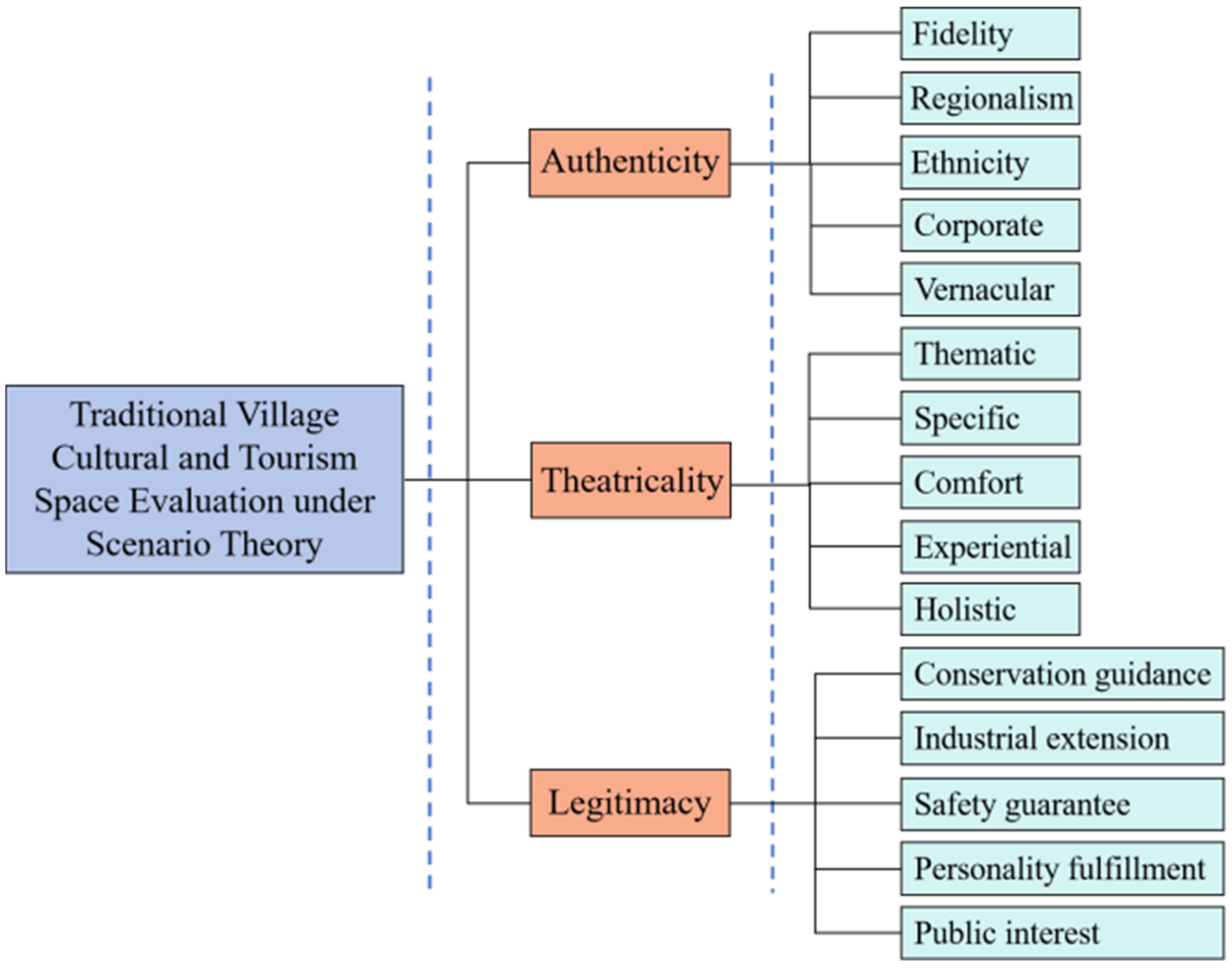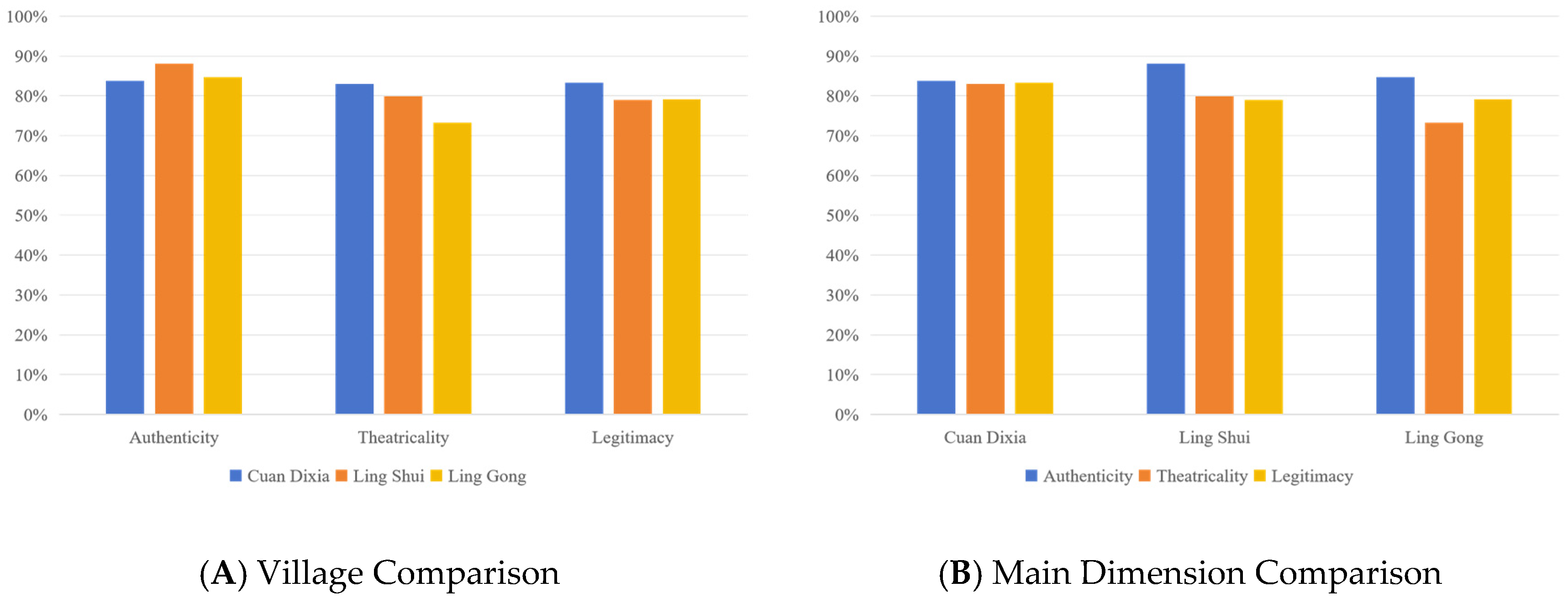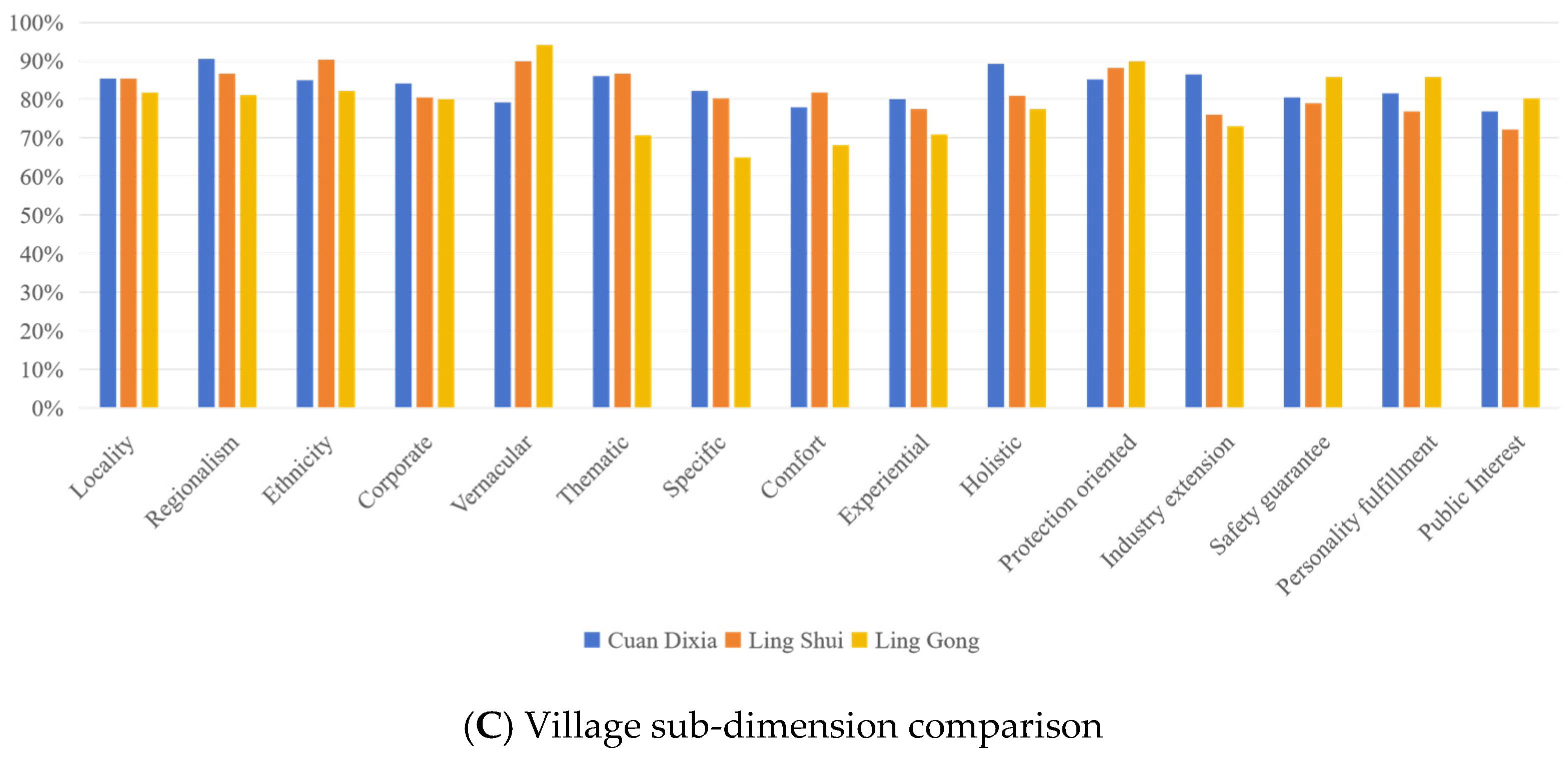Traditional Villages’ Cultural Tourism Spatial Quality Evaluation
Abstract
1. Introduction
2. Methods
2.1. Theoretical Foundation
2.2. Characteristics of Scene Theory Application
3. Construction of Evaluation Index System
3.1. Construction of the Indicator System
3.2. Main Dimension Interpretation
3.3. Sub-Dimensional Interpretation
3.3.1. Authenticity Sub-Dimension
3.3.2. Theatricality Sub-Dimension
3.3.3. Legitimacy Sub-Dimension
4. Evaluation System Indicator Empowerment
4.1. Constructing Judgement Matrices
4.2. Specific Calculation Models
4.3. Generating Indicator Weights
4.4. Methods of Applying the Evaluation System
5. Evaluation Results of the Spatial Quality of Cultural Tourism in Traditional Villages
5.1. Evaluation of Village Profiles
5.2. Results of the Evaluation of the Quality of Cultural and Tourism Spaces
5.3. Analysis of Results
6. Conclusions and Implications
6.1. Research Conclusions
6.2. Limitations and Prospects
Author Contributions
Funding
Institutional Review Board Statement
Informed Consent Statement
Data Availability Statement
Conflicts of Interest
References
- Nicole, V. Modern public spaces in Canada: A revaluation. J. Landsc. Archit. 2020, 15, 20–33. [Google Scholar]
- Wang, W.J.; Makoto, W.; Kenta, O.; Zhou, D.H. Exploring Visualisation Methodology of Landscape Design on Rural Tourism in China. Buildings 2022, 12, 64. [Google Scholar] [CrossRef]
- Li, W.; Zhou, Y.; Zhang, Z.W. Strategies of Landscape Planning in Peri-Urban Rural Tourism: A Comparison between Two Villages in China. Land 2021, 10, 277. [Google Scholar] [CrossRef]
- Su, T.T.; Wang, K.P.; Li, S.S.; Wang, X.Y.; Li, H.; Ding, H.R.; Chen, Y.F.; Liu, C.H.; Liu, M.; Zhang, Y.L. Analysis and Optimization of Landscape Preference Characteristics of Rural Public Space Based on Eye-Tracking Technology: The Case of Huangshandian Village, China. Sustainability 2022, 15, 212. [Google Scholar] [CrossRef]
- Qiu, Z.; Wang, Y.; Bao, L.; Yun, B.W.; Lu, J. Sustainability of Chinese Village Development in a New Perspective: Planning Principle of Rural Public Service Facilities Based on “Function-Space” Synergistic Mechanism. Sustainability 2022, 14, 8544. [Google Scholar] [CrossRef]
- Li, Y.N.; Ismail, A.M.; Aminuddin, A. How has rural tourism influenced the sustainable development of traditional villages? A systematic literature review. Heliyon 2024, 10, e25627. [Google Scholar]
- Shen, H.H.; Fadzila, A.N.; Huang, M.L.; Yu, L.Y.; Liu, Z.G. Tourist perceptions of landscape in Chinese traditional villages: Analysis based on online data. J. Tour. Cult. Chang. 2024, 22, 232–251. [Google Scholar] [CrossRef]
- Wang, Y.S.; Zhang, Z.H. Research on the Composition and Evaluation of Local Knowledge of Traditional Village Landscape—Taking Yuanjia Village as an Example. Chin. Landsc. Archit. 2021, 12, 21. (In Chinese) [Google Scholar]
- Song, R.; Shi, G.S.; Wu, Z.P. Research on the Design of Rural Cultural Tourism Space under the Background of Rural Revitalization. J. Landsc. Res. 2024, 16, 38–41. [Google Scholar]
- Ren, X.B.; Ren, H.J.; Hao, W.Q.; Zhao, Y.L. Comparative Study on the Vitality of Typical Historical Districts in Beijing from the Perspective of Scene Theory. Acad. J. Archit. Geotech. Eng. 2024, 6, 1–7. [Google Scholar]
- Xiao, H.G.; Li, L. Villagers’ Perceptions of Traditions: Some Observations on the Development of Rural Cultural Tourism in China. Tour. Recreat. Res. 2004, 29, 69–80. [Google Scholar] [CrossRef]
- Liu, X.D.; Huang, Y.; Xiang, H.L.; Zhang, C.; Chen, J.; Xiao, D.W. Optimization strategies for the management mechanisms of conservation and utilization in traditional Chinese villages based on relevance analyses of performance evaluation. J. Asian Archit. Build. Eng. 2023, 22, 1699–1713. [Google Scholar] [CrossRef]
- Song, H.S.; Huang, D.C.; Zhu, Q.X. Research on the Guidance for Traditional Village Protection and Development Based on Functionalism Perspective. Adv. Mater. Res. 2011, 1269, 6615–6619. [Google Scholar] [CrossRef]
- Wang, T.; Adeyeye, K.; Wang, D.S.; Gu, H.B.; Chen, S.L. The Reconciliation of the Contradictions in the Preservation and Development of Traditional Villages: Refinement of Contradictions through Extenics. Procedia Comput. Sci. 2017, 122, 1149–1155. [Google Scholar] [CrossRef]
- Liu, T.; Wang, S.J.; Wang, Z.; Li, B.X.; Guo, S.L.; Wei, B.W. Data science based landscape ecology for traditional village landscape protection. Int. J. Comput. Appl. Technol. 2021, 65, 290–300. [Google Scholar] [CrossRef]
- Wang, S.J.; Sun, J.X. Construction and Empirical Evidence of Evaluation System for Sustainable Development of Traditional Villages in China. Acta Geogr. Sin. 2021, 76, 921–938. (In Chinese) [Google Scholar]
- Dou, Y.T.; Xie, S.X.; Li, B.H. Multidimensional Value Evaluation and Empirical Research on Traditional Villages. J. Cent. South For. Univ. For. Technol. (Soc. Sci.) 2020, 14, 77–83. (In Chinese) [Google Scholar]
- Dong, Y. Preservation and Utilization of Industrial Heritage from the Perspective of Scene Theory: A Case Study of the North Area of Shougang High-End Industry Comprehensive Service Zone. In Proceedings of the 2023 2nd International Conference on Urban Planning and Regional Economy (UPRE 2023), Beijing, China, 21–23 April 2023; Atlantis Press: Amsterdam, The Netherlands, 2023. [Google Scholar] [CrossRef]
- Zhang, Y. Urban Development from the Perspective of Scene Theory-Jingdezhen Post-industrial Era. In Proceedings of the 7th International Conference on Education, Management, Information and Mechanical Engineering (EMIM 2017), Shenyang, China, 28–30 April 2017; Atlantis Press: Amsterdam, The Netherlands, 2017; pp. 1924–1927. [Google Scholar] [CrossRef]
- Clark, T.N.; Li, L. The Concept and Analysis of Scene Theory: Implications for China from Multinational Studies. Dongyue Trib. 2017, 38, 16–24. [Google Scholar]
- Okoro, C.S. Sustainable facilities management in the built environment: A mixed-method review. Sustainability 2023, 15, 3174. [Google Scholar] [CrossRef]
- Wei, D.M.; Wang, Z.X.; Zhang, B. Traditional Village Landscape Integration Based on Social Network Analysis: A Case Study of the Yuan River Basin in South-Western China. Sustainability 2021, 13, 13319. [Google Scholar] [CrossRef]
- Wan, H.L.; Sikka, S. Spatial Sequence Evolution—Research on the Sustainable Development of Rural Tourism Space. Acad. J. Archit. Geotech. Eng. 2023, 5, 1–9. [Google Scholar]
- Si, J.X. Research on Scenario Reconstruction of Space in Old Community. Front. Soc. Sci. Technol. 2023, 5, 121–126. [Google Scholar]
- Chermack, J.T. Studying scenario planning: Theory, research suggestions, and hypotheses. Technol. Forecast. Soc. Chang. 2003, 72, 59–73. [Google Scholar] [CrossRef]
- Mao, W.; Hong, S.; Chai, T.F.; Shen, J.C.; Shen, J. Cultural Landscape Reproduction of Typical Religious Architecture in Qingjiangpu Based on Scene Theory. Appl. Sci. 2022, 13, 82. [Google Scholar] [CrossRef]
- Chen, B.; Yan, S.N. Research on Cultural Value Enhancement of Non-heritage Tourist Places under Scene Theory: Based on Data Analysis of 27 Non-heritage Tourist Towns in Zhejiang Province. J. Tongji Univ. (Soc. Sci. Ed.) 2022, 33, 20–32. (In Chinese) [Google Scholar]
- Wang, T.; Zhu, Y.Z.; Zhang, Q.R. A Study on the Renewal of Industrial Land in Guangzhou under the Perspective of Scenario Theory–Taking Cultural and Creative Industrial Park as an Example. Mod. Urban Res. 2021, 36, 66–7282. (In Chinese) [Google Scholar]
- Liu, H.J. Student education management model and formation in universities based on hierarchical analysis. Appl. Math. Nonlinear Sci. 2024, 9. [Google Scholar] [CrossRef]
- Xu, Q.; Wang, J. Recognition of Values of Traditional Villages in Southwest China for Sustainable Development: A Case Study of Liufang Village. Sustainability 2021, 13, 7569. [Google Scholar] [CrossRef]
- Silva, D.B.F.R.; Rodrigues, A.D.M.; Vieira, A.S.; Batistella, M.; Farinaci, J. Perspectives for environmental conservation and ecosystem services on coupled rural–urban systems. Perspect. Ecol. Conserv. 2017, 15, 74–81. [Google Scholar] [CrossRef]
- Zhou, Y. Strategies to Promote Smart City Cultural Scene Construction through Multi-Sensor Fusion Data. Mob. Inf. Syst. 2022, 2022, 6890117. [Google Scholar] [CrossRef]
- Liu, M.H.; Li, X.Y.; Ren, Q.Y. Rural Festivals and Rural Cultural Spaces Creation: A Case Study of the “Yim Tin Tsai Arts Festival”. Int. J. Arts Humanit. Stud. 2023, 3, 10–17. [Google Scholar]
- Luo, D. Analysis of Successful Cases Based on Rural Heritage Conservation and Community Participation. Acad. J. Humanit. Soc. Sci. 2024, 7, 76–82. [Google Scholar]
- Mori, M. The Localness, Materiality, and Visuality of Landscape in Japan. Jpn. J. Hum. Geogr. 2014, 66, 522–535. [Google Scholar]
- Deng, K. Exploration of Renewal and Renovation Design of Historical and Cultural Protection Areas Based on Smart Cities. J. Civ. Eng. Urban Plan. 2024, 6, 93–97. [Google Scholar]
- Miao, M.R.; Feng, L.H.; Wu, Y.; Zhu, R.; Xu, D.W. Color Authenticity for the Sustainable Development of Historical Areas: A Case Study of Shiquan. Sustainability 2024, 16, 2417. [Google Scholar] [CrossRef]
- Luescher, A. Sculpting Spatial Theatricality: Snøhetta’s Petter Dass Museum and Steven Holl’s Knut Hamsun Centre. Archit. Cult. 2020, 8, 176–192. [Google Scholar] [CrossRef]
- Olivier, M.M.; Howard, L.J.; Wilson, P.B.; Robinson, A.W. Correlating Localisation and Sustainability and Exploring the Causality of the Relationship. Ecol. Econ. 2018, 146, 749–765. [Google Scholar] [CrossRef]
- Wang, X.Y.; Guo, W.M.; Yang, Z.; Li, X.Y.; Zhang, B.W. Localisation of Composite capital designs in modern Jiangsu, China, based on formal and social analysis. Humanit. Soc. Sci. Commun. 2023, 10, 560. [Google Scholar] [CrossRef]
- Rong, Y.F.; Wang, Z.X.; Cao, S.J. Cultural Space Creation and Development Strategy of Traditional Villages in the Context of Culture and Tourism Integration—Taking Bao Tun Village of Anshun City as a Case Study. Dev. Small Cities Towns 2021, 39, 32–39. (In Chinese) [Google Scholar]
- Changguk, K.; Dongyun, K. Formation of Sense of Place Trough Urban Design Project in Chiba, Japan: Relationships between Change of Emotional Values and Experiential Recognition of Place. Int. Rev. Spat. Plan. Sustain. Dev. 2022, 10, 108–127. [Google Scholar]
- Lechner, M.A.; Brown, G.; Raymond, M.C. Modeling the impact of future development and public conservation orientation on landscape connectivity for conservation planning. Landsc. Ecol. 2015, 30, 699–713. [Google Scholar] [CrossRef]
- Cheng, R.L.; Wu, M.Y.; Liu, X.L.; Song, X.Q.; Zhang, Y.W. Research on the Measurement and Improvement Strategy of Integration of Agriculture, Culture and Tourism in Hebei Province Under the Strategy of Rural Revitalization. Adv. Sustain. 2024, 3, 19–22. [Google Scholar] [CrossRef]
- Zhao, P.P.; Zuraini, A.M.; Yahaya, A. Developing indicators for sustainable urban regeneration in historic urban areas: Delphi method and Analytic Hierarchy Process (AHP). Sustain. Cities Soc. 2023, 99, 104990. [Google Scholar] [CrossRef]
- Cai, P.; Zhang, X.P.; Xing, Y.Y.; Chen, F.L.; Qu, H.M.; Lou, J.X.; Li, Y. Evaluation of spatial form of rural ecological landscape and vulnerability of water ecological environment based on analytic hierarchy process. Open Geosci. 2023, 15, 20220540. [Google Scholar] [CrossRef]
- Yuan, M.; Kang, J.L.; Chan, D.K. A Study on the Traditional Color Analysis of Chinese Historic Village—Focus on Cuan Dixia Village of Mentougou District in Beijing. J. Korean Inst. Tradit. Landsc. Archit. 2015, 33, 112–128. [Google Scholar]
- Chang, L.H.; Qian, W.; Xun, T.L.; Bi, Y.Z. Protection and Development of Traditional Villages in the Suburbs of Beijing--The Case of Ling Shui Village. J. Beijing Univ. Agric. 2020, 35, 73–76. (In Chinese) [Google Scholar]
- Sun, L.; Zhou, Y.F.; Sun, X.P.; Wang, T.; Yang, Z. Research on Spatial Morphology Analysis of Traditional Villages Based on Spatial Syntax—The Case of Ling Gong Village in Beijing Municipality. J. Beijing Univ. Civ. Eng. Archit. 2023, 39, 1–9. (In Chinese) [Google Scholar]




| Principal Dimension | Sub-Dimension | Principal Dimension | Sub-Dimension | Principal Dimension | Sub-Dimension |
|---|---|---|---|---|---|
| Authenticity | Rational | Theatricality | Goodwill | Legitimacy | Traditionalism |
| Local | Formal | Self-expression | |||
| National | Showcase | Pragmatism | |||
| Group | Fashion | Leadership | |||
| Ethnicity | Irregular | Egalitarianism |
| Authenticity | Theatricality | Legitimacy | |||
|---|---|---|---|---|---|
| C1 Locality | Architectural conservation dimensions | C6 Thematic | Cultural tourism theme IP | C11 Conservation guidance | Preservation of historical and cultural values |
| C2 Regionalism | Landscape spatial character | C7 Specific | Culture material expression | C12 Industry extension | Socio-economic benefit production |
| C3 Ethnicity | Cultural and tourism activity characteristics | C8 Comfort | Space facilities’ serviceability | C13 Safety guarantee | Sense of security and adaptability |
| C4 Corporate | Service space | C9 Experiential | Space facilities’ interactivity | C14 Personality fulfilment | Personalised emotional expression |
| C5 Vernacular | Environment and humanistic atmosphere | C10 Holistic | Cultural and tourism elements’ coordination and integration | C15 Public interest | Public will expression |
| Assign a Value to aij | Factor i Compares to Factor j |
|---|---|
| 1 | Equally important |
| 3 | Slightly important |
| 5 | Significantly important |
| 7 | Strongly important |
| 9 | Extremely important |
| 2, 4, 6, 8 | Median of two neighbouring judgments |
| Reciprocal | aji = 1/aij |
| C1 | C2 | ⋯ | Cn | |
|---|---|---|---|---|
| C1 | 1 | a12 | ⋯ | a1n |
| C2 | a21 | 1 | ⋯ | a2n |
| ⋯ | ⋯ | ⋯ | 1 | ⋯ |
| Cn | an1 | an2 | ⋯ | 1 |
| Objective | Criterion | Weight | Evaluation Index | Feature Vector | Index Weight | Coefficient Weight |
|---|---|---|---|---|---|---|
| Traditional Village Cultural and Tourism Space Evaluation | Authenticity | 0.3643 | Locality | 0.1573 | 0.1573 | 0.0573 |
| Regionalism | 0.0415 | 0.0414 | 0.0151 | |||
| Ethnicity | 0.5423 | 0.5424 | 0.1976 | |||
| Corporate | 0.0582 | 0.0582 | 0.0212 | |||
| Vernacular | 0.2008 | 0.2009 | 0.0732 | |||
| Theatricality | 0.5368 | Thematic | 0.0479 | 0.0479 | 0.0257 | |
| Specific | 0.1492 | 0.1492 | 0.0801 | |||
| Comfort | 0.0597 | 0.0596 | 0.032 | |||
| Experiential | 0.3932 | 0.3933 | 0.2111 | |||
| Holistic | 0.35 | 0.3500 | 0.1879 | |||
| Legitimacy | 0.0989 | Protection-oriented | 0.0413 | 0.0415 | 0.0041 | |
| Industry extension | 0.4419 | 0.4419 | 0.0437 | |||
| Safety guarantee | 0.1433 | 0.1436 | 0.0142 | |||
| Personality fulfilment | 0.3047 | 0.3043 | 0.0301 | |||
| Public interest | 0.0689 | 0.0688 | 0.0068 |
| Primary Index | Secondary Index | Cuan Dixia | Ling Shui | Ling Gong | Coefficient Weight |
|---|---|---|---|---|---|
| Authenticity | Locality | 85.44 | 85.32 | 81.74 | 0.0573 |
| Regionalism | 90.55 | 86.66 | 81.12 | 0.0151 | |
| Ethnicity | 84.91 | 90.42 | 82.32 | 0.1976 | |
| Corporate | 84.23 | 80.52 | 80.12 | 0.0212 | |
| Vernacular | 79.33 | 89.90 | 94.23 | 0.0732 | |
| Overall | Weighted Score | 83.82 | 88.12 | 84.66 | 0.3643 |
| Theatricality | Thematic | 85.97 | 86.75 | 70.67 | 0.0257 |
| Specific | 82.23 | 80.34 | 64.95 | 0.0801 | |
| Comfort | 77.89 | 81.82 | 68.11 | 0.032 | |
| Experiential | 80.20 | 77.62 | 70.97 | 0.2111 | |
| Holistic | 89.33 | 80.95 | 77.57 | 0.1879 | |
| Overall | Weighted score | 83.04 | 79.94 | 73.20 | 0.5368 |
| Legitimacy | Protection oriented | 85.22 | 88.20 | 89.94 | 0.0041 |
| Industry extension | 86.46 | 76.07 | 72.98 | 0.0437 | |
| Safety guarantee | 80.53 | 78.95 | 85.94 | 0.0142 | |
| Personality fulfilment | 81.56 | 77.00 | 85.89 | 0.0301 | |
| Public interest | 76.84 | 72.32 | 80.23 | 0.0068 | |
| Overall | Weighted score | 83.23 | 78.99 | 79.18 | 0.0989 |
| Final weighted score | 83.79 | 82.28 | 77.06 | 1 | |
Disclaimer/Publisher’s Note: The statements, opinions and data contained in all publications are solely those of the individual author(s) and contributor(s) and not of MDPI and/or the editor(s). MDPI and/or the editor(s) disclaim responsibility for any injury to people or property resulting from any ideas, methods, instructions or products referred to in the content. |
© 2024 by the authors. Licensee MDPI, Basel, Switzerland. This article is an open access article distributed under the terms and conditions of the Creative Commons Attribution (CC BY) license (https://creativecommons.org/licenses/by/4.0/).
Share and Cite
Li, Q.; Lv, S.; Chen, Z.; Cui, J.; Li, W.; Liu, Y. Traditional Villages’ Cultural Tourism Spatial Quality Evaluation. Sustainability 2024, 16, 7752. https://doi.org/10.3390/su16177752
Li Q, Lv S, Chen Z, Cui J, Li W, Liu Y. Traditional Villages’ Cultural Tourism Spatial Quality Evaluation. Sustainability. 2024; 16(17):7752. https://doi.org/10.3390/su16177752
Chicago/Turabian StyleLi, Qin, Shuangning Lv, Zonghao Chen, Jingya Cui, Wenlong Li, and Yijun Liu. 2024. "Traditional Villages’ Cultural Tourism Spatial Quality Evaluation" Sustainability 16, no. 17: 7752. https://doi.org/10.3390/su16177752
APA StyleLi, Q., Lv, S., Chen, Z., Cui, J., Li, W., & Liu, Y. (2024). Traditional Villages’ Cultural Tourism Spatial Quality Evaluation. Sustainability, 16(17), 7752. https://doi.org/10.3390/su16177752






